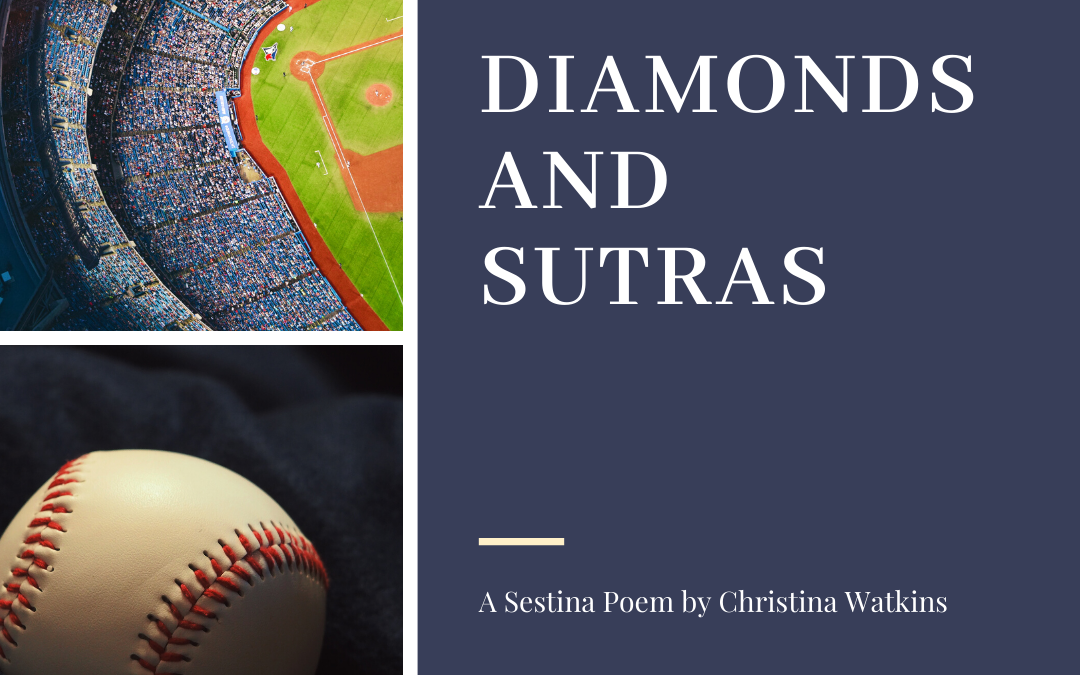
by Christina Watkins | May 26, 2020 | Poems
DIAMONDS AND SUTRAS: A Sestina, written June 21, 2013.
‘Diamonds and Sutras’ is in Poems for the Journey.
Read my tutorial on how to write a Sestina here. I hope you will enjoy it.
Some people make their fortunes finding diamonds.
Others practice knowledge of the sutras.
Everyone loves listening to stories.
Many forget their worries watching baseball.
I wonder how we all live into surrender
know that all shall be well beyond space and time.
In a game with rules and the mystery of time-
out, played in an open field shaped like a diamond,
playing together requires a kind of surrender.
Commentary for this could be based on the sutras.
Long afternoons richly spent focused on baseball
bring on dreams and become the stuff of stories.
From the beginning I read our children stories.
Those were the final innings of every bedtime.
My own childhood was enriched by the game of baseball.
It was lovely to spend that time focused on diamonds.
Now I’m writing poems and reading the sutras.
Batting and running help me balance surrender.
Lack of balance leads to uncentered surrender.
Practice and play take us home again to our stories.
Some things can be explained best through the sutras.
A practice of love is active over time.
Many assume that all of us are diamonds.
Groups of three can remind us of more than baseball.
Evenings spent under the stars watching baseball –
with overtime the splendid surrender
to freedom from clocks — a treat as rare as diamonds —
replay in my heart as memory that has become story.
One day I’ll write a poem about the time
when ‘It ain’t over till it’s over’ became my sutra.
Playing is more precious even than sutras.
Plenty has come to me through games like baseball.
Nothing moves more relentlessly than time.
Now I gather my strength for what seems like surrender
while praying and paying close attention to stories
about lives of fire and ice brighter than diamonds.
Our grandchildren now play baseball on diamonds.
We make up sutras to help them with surrender —
enrichment for us and our stories over time.
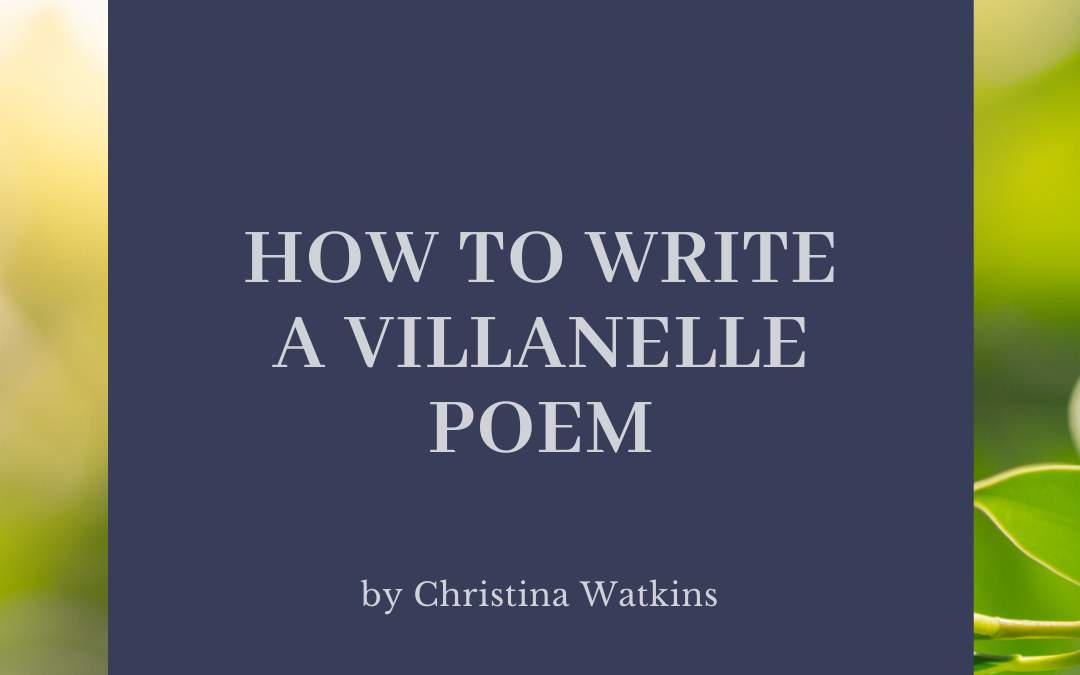
by Christina Watkins | May 11, 2020 | Poems
‘The Way Things Are Is Large,’ is a villanelle in Poems for the Journey p.19. I like writing poems that have some form. It helps get me started with words on the page. Two strong lines about things the poet cares deeply about give energy for finding the other lines. For a while this poem was called ‘Earth Suffused With Light,’ when I saw it again I knew to go back to this original title, ‘The Way Things Are Is Large.’ Hope people try this and have fun with it. The lines can be one very silly and one serious.
VILLANELLE FORM
A, REFRAIN 1
B
A, REFRAIN 2
A
B
A, REFRAIN 1
A
B
A, REFRAIN 2
A
B
B. REFRAIN 1
A
B
REFRAIN 2
A
B
A, REFRAIN 1
A. REFRAIN 2
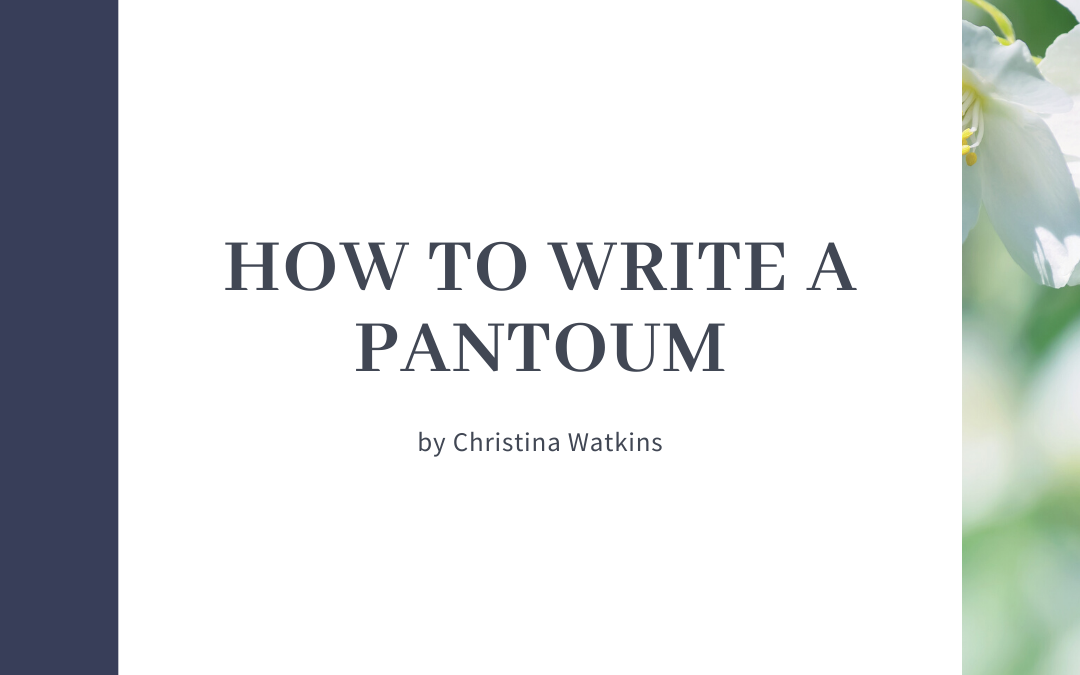
by Christina Watkins | May 4, 2020 | Poems
There are three pantoums in Poems ~ Poemas:
- ‘Wind Whispers,’ p.10, ‘El viento susurra,’ p.11
- ‘Far Traveler,’ p.30, Un viajero lejano,’p.31
- ‘East Says,’p.52,’ El este dice,’p.53
Here is the pantoum ‘East Says:’
East Says
East says set the second half of life aside for ecstasy.
What better prospect than to be a dancer?
Some say St. Paul was reading in the roadside shade
I have begun to feel the urge to drown my books.
What better prospect than to be a dancer?
Wind is handing out invitations at the door.
I have begun to feel the urge to drown my books.
Retreats are being offered in wild-mind.
Wind is handing out invitations at the door.
Some say St. Paul was reading in the roadside shade.
Retreats are being offered in wild-mind.
East says set the second half of life aside for ecstasy
‘East Says’ is a pantoum. Pantoums can be fun to write. I find them fun to write because
of the repeating lines. I also like that the first line of the poem is the same as the last line.
Here is the outline of the form from Ron Padgett’s The Teachers & Writers Handbook of
Poetic Forms.
”The Western version of the pantoum is a poem of indefinite length made up of stanzas
whose four lines are repeated in a pattern: lines 2 and 4 of each stanza are repeated as
lines 1 and 3 of the next stanza.
line 1
line 2
line 3
line 4
line 5 same as line 2
line 6
line 7 same as line 4
line 8
line 9 same as line 6
line 10
line 11 same as line 8
line 12”
Have fun!
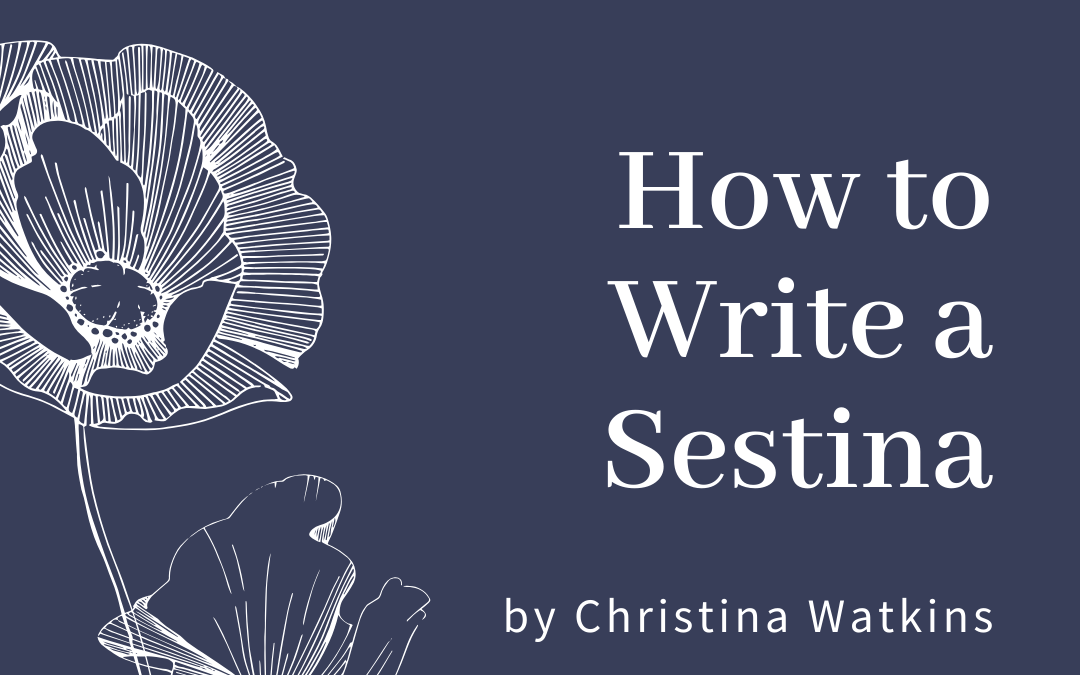
by Christina Watkins | May 3, 2020 | Poems
It is fun and easy to write a sestina. There are two sestinas in Poems for the Journey: ‘Waves,’ p.11 and ‘Diamonds and Sutras, ’p.15.
The sestina form allows the poet to get lines up on the screen and then play around with the words that come before the end word in every line. During a period of ‘writer’s block,’ a sestina can help writers have something to work with.
It is fun and easy to write a sestina and the form allows the poet to put something up on the computer screen and play with the words. In a time of writer’s block a sestina can sometimes help the writer have something to work with.
Sestina is a verse form with six unrhymed sestets (six line stanzas), each with the same set of final words arranged in different order. The sestina concludes with a three-line stanza that incorporates all six repeated words.
Choose six words with energy for you. Two or three of the words will have less energy than the other words and that is good. Once you have written the first stanza you are on your way.
You can either mix up the six words in each stanza or follow this form.
1 st stanza: 123456
2 nd stanza: 615243
3 rd stanza: 364125
4 th stanza: 532614
5 th stanza: 451362
6 th stanza: 246531
Write a final three line stanza with one of the core words in the middle of each line and another at the end. Read my poem, Diamonds and Sutras which is an example of a sestina.
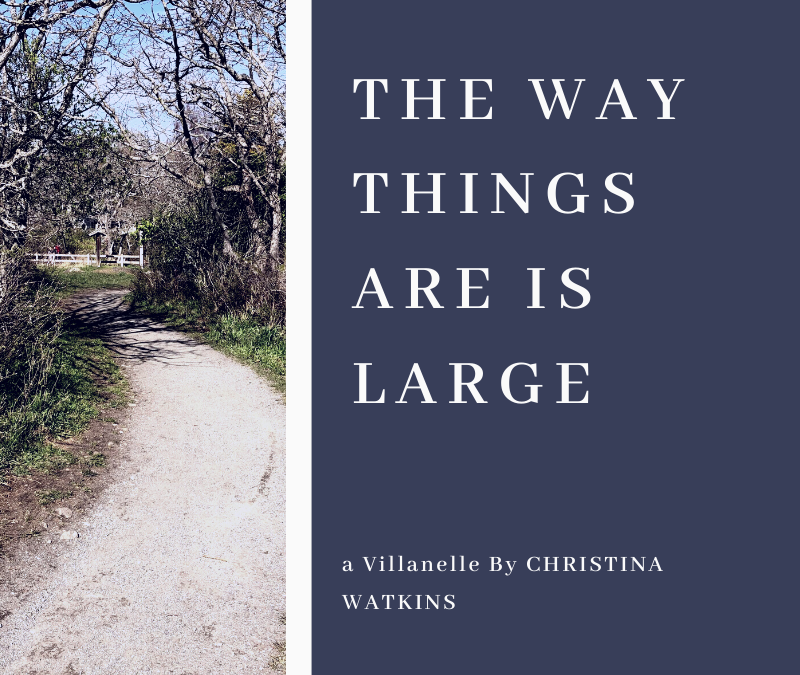
by Christina Watkins | Apr 25, 2020 | Poems
The way things are is large, too wonderful to understand.
Love teaches by story, portrays our needs.
But what is it that makes us human?
Story tells of a garden, suggests a plan.
We learn which are flowers, are warned of weeds.
The way things are is large, too wonderful to understand
We hear more stories, the collection is grand,
tales of flood and drought, of gift and greed.
But what is it that makes us human?
With myriad creatures, we share the land.
In hopes and hungers we seek what we need.
The way things are is large, too wonderful to understand.
The garden is a mix of loam, weeds and sand.
From above come sun, rain and seeds.
But what is it that makes us human?
One story says a time will come for outstretched hands,
a part of the path where we follow another’s lead.
The way things are is large, too wonderful to understand.
But what is it that makes us human?
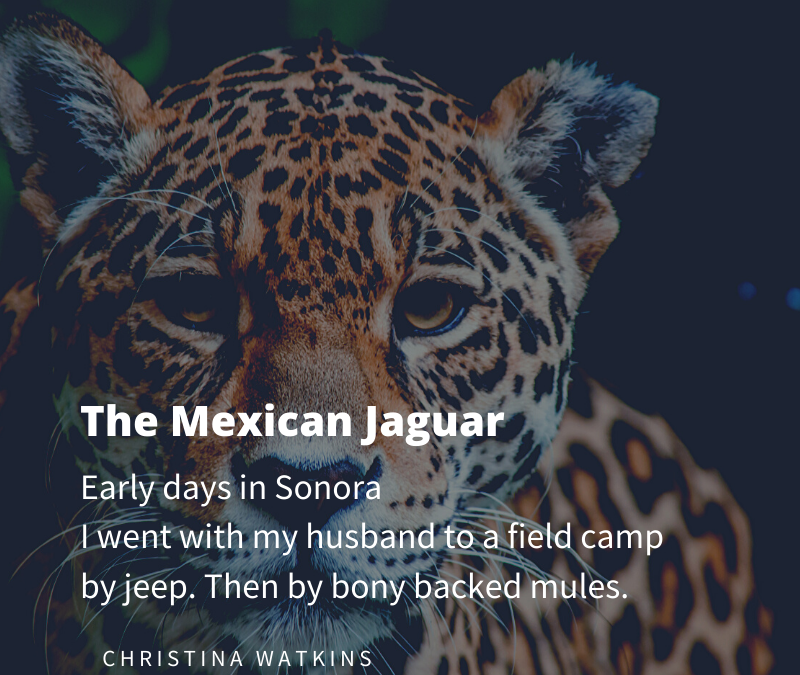
by Christina Watkins | Mar 6, 2020 | Poems
Early in our days in Sonora
I went with my husband to a field camp
by jeep. Then bony backed mules.
The eight Mexicans there were shy as
we said Buenos días to each other.
Next morning they answered my Buenos días
with Buenos días le dé Dios.
It became like that.
I stayed in camp all day.
They went out to hammer rocks in
country known as baranca –
place of broken boulders.
My husband and I slept that night
in the small cook shack cabin.
The Mexicans in sleeping bags
circled close round the fire.
Next morning fear was in the camp.
Talk was in rapid nervous Spanish.
We heard gato – cat and pero – dog
and a word we did not know — Onca.
The Mexicans said I must not be left alone.
Our Spanish was not good
in those early days in Mexico.
We thought gato would be a lynx.
That night the Mexicans stayed up late talking.
In the morning the second dog was gone.
In spite of anxious warnings from the Mexicans
I stayed in camp reading by the river.
After lunch — to the relief of the Mexicans —
my husband and I went back to our town
by bony backed mules and jeep.
Years later– in Tucson’s Desert Museum —
we saw a sign saying Onca.
We turned a corner towards it — then
suddenly faced a brown, black and gold
Painted Jaguar —
huge and confident looking.
I felt my full foolishness.
The Mexicans in that long ago camp —
wanted me safe – in spite of myself.
They were my blessing.
Christina Watkins






Recent Comments